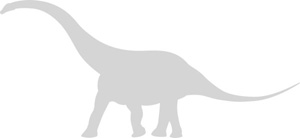Every month, 100,000 readers use the Dinosaur Database, but we receive no support from you. Developing and updating the database requires a lot of work. If you want it to remain open and be updated, please support us via the "Buy us a coffee" button available on every page or via the Support page.
Dinosaur: Giraffatitan brancai

| Length*: | 25 m | 82.0 ft |
| Weight*: | 50 t | 110,231 lb |
| Speed: | 25 km/h | 16 mph |
*The largest known specimen
Description
Giraffatitan brancai
Giraffatitan brancai was one of the tallest and most massive dinosaurs to ever walk the Earth, living around 150 to 145 million years ago during the Late Jurassic period. Its name means “giant giraffe,” reflecting its long neck and towering stature. Originally classified as a species of Brachiosaurus, it was later given its own genus due to distinct differences in its skeletal structure. Fossils of Giraffatitan have been primarily discovered in what is now Tanzania, East Africa, making it one of the best-known sauropods from this region.
Physical Characteristics
Giraffatitan brancai was a colossal sauropod dinosaur, measuring up to 22–26 meters (72–85 feet) in length and standing around 12 meters (39 feet) tall, with a weight estimated at 30–60 metric tons. The largest known specimen: 48 tons (105,82 pounds). It had a long neck, composed of elongated cervical vertebrae, allowing it to reach high into the trees to feed. Unlike other sauropods, Giraffatitan had a more upright posture due to its long, front-facing forelimbs, giving it a distinctive, giraffe-like profile. Its skull was relatively small, with nostrils located high on the head, possibly aiding in regulating body temperature or enhancing its sense of smell. The dinosaur’s massive body was supported by pillar-like legs, similar to those of modern elephants, and a long tail that likely served as a counterbalance to its neck.
Diet and Feeding Habits
As a herbivore, Giraffatitan primarily fed on high-growing vegetation, such as conifers, cycads, and ginkgoes, which were abundant during the Late Jurassic. Its long neck allowed it to browse at heights unreachable by other herbivores, giving it access to food sources that other dinosaurs could not reach. The structure of its teeth suggests that it was adapted to stripping leaves from branches rather than chewing, and it likely swallowed vegetation whole, relying on gastroliths (stones swallowed to aid digestion) and a large, fermenting gut to break down plant material.
Habitat and Distribution
Giraffatitan brancai lived in what is now the Tendaguru Formation in Tanzania, which during the Late Jurassic was a low-lying, coastal environment with a warm, semi-arid climate. The region consisted of floodplains, river channels, and savanna-like areas that supported a diverse array of flora and fauna. The fossils found in the Tendaguru beds have revealed a rich ecosystem that included a variety of sauropods, theropods, and other reptiles, making it one of the most important dinosaur sites in Africa.
Behavior and Social Structure
The social behavior of Giraffatitan is not well understood, but it is likely that, like many sauropods, it lived in herds for protection against predators and to aid in finding food. Herding behavior would have provided safety in numbers, particularly for juveniles, which were more vulnerable to large predators such as “Allosaurus” tendagurensis or Ceratosaurus. Evidence from other sauropods suggests that these animals may have traveled long distances in search of food and water, following seasonal patterns in their environment.
Discovery and Research
Giraffatitan brancai was discovered during the German Tendaguru Expedition between 1909 and 1912, led by paleontologist Werner Janensch. The species was originally described as Brachiosaurus brancai in 1914, but later research showed significant anatomical differences, leading to its reclassification as a separate genus, Giraffatitan, in 1988 by paleontologists Greg Paul and George Olshevsky. The fossils, including several nearly complete skeletons, are among the most complete sauropod remains ever found and are housed at the Museum für Naturkunde in Berlin, where a mounted skeleton is one of the largest (tallest) dinosaur exhibits in the world.
Significance and Interesting Facts
Giraffatitan is significant for its immense size and its role as one of the largest known dinosaurs. Its discovery has provided critical insights into the biology and evolution of sauropods, particularly in terms of their anatomy, growth, and ecology. The unique body structure of Giraffatitan suggests it may have had specialized adaptations for high browsing, setting it apart from other sauropods of its time. Its skeleton has also been pivotal in understanding the biomechanics of large dinosaur movement, including how such massive animals could walk and support their weight.
Locations
Sources
Material: Probably more than 30 individuals.
References: Taylor, M.P. (2009) "A re-evaluation of Brachiosaurus altithorax Riggs 1903 (Dinosauria, Sauropoda) and its generic separation from Giraffatitan brancai (Janensch 1914)" .




